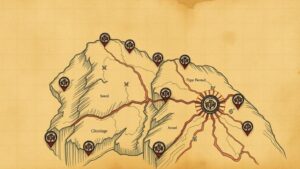How to Excavate Treasure in Areas With Active Underwater Currents
How to Excavate Treasure in Areas With Active Underwater Currents
Excavating treasure from sites with active underwater currents presents unique challenges and opportunities for treasure hunters and marine archaeologists alike. This guide aims to break down the methods, tools, and considerations necessary for successful excavation in such environments. By understanding the dynamics of underwater currents and employing appropriate techniques, excavators can increase their chances of discovering valuable artifacts while ensuring safety and minimizing environmental impact.
Understanding Underwater Currents
Underwater currents are created by various factors, including wind, tidal changes, and the Earths rotation. e currents can vary in speed and direction, significantly affecting excavation efforts. Active currents may hinder visibility, make navigation challenging, and pose safety risks to divers. According to the National Oceanic and Atmospheric Administration (NOAA), currents in coastal regions can often exceed 2 knots, which can dramatically impact the excavation process.
Assessing the Site
Before starting an excavation project, it is critical to assess the site thoroughly. This assessment includes:
- Site Surveys: Conducting underwater surveys using sonar technology can help identify topographical features of the seabed that may indicate treasure deposits.
- Currents and Tides: Understanding the patterns of local currents and tidal movements will inform the timing and methods used for excavation.
- Environmental Impact: Assessing potential ecological consequences is crucial, as excavation efforts can disrupt marine habitats.
Case studies, such as those conducted by the Florida Keys National Marine Sanctuary, illustrate the effectiveness of thorough site assessments. Their research on shipwreck sites has led to safer, more effective excavation strategies tailored to specific current conditions.
Choosing the Right Equipment
The selection of equipment is essential when working in areas with strong underwater currents. Some key items to consider include:
- Diving Gear: High-quality diving gear, including wetsuits and buoyancy control devices, is vital for safety and comfort in active currents.
- Specialized Tools: Tools such as underwater metal detectors, excavation buckets, and diving sleds can significantly aid in the retrieval of artifacts.
- Surface Support Equipment: Boats equipped with anchors and GPS technology should be deployed to provide stable support and facilitate safe operations.
For example, treasure hunters involved in the 1715 Spanish Galleon fleet recovery off Floridas coast employed underwater metal detectors and specialized diving units to locate gold coins buried under shifting sands due to tidal currents. r approach highlights the importance of appropriate gear in mitigating the challenges posed by underwater environments.
Developing Diving Techniques
Proper diving techniques are crucial when excavating treasure in active currents. Divers must be trained in specific methodologies, including:
- Understanding Drift Diving: This technique allows divers to utilize currents effectively by planning entry and exit points while minimizing resistance.
- Using Safety Lines: Employing safety lines can help divers maintain stability, especially when currents are strong.
- Buddy Systems: Divers should always work in pairs, ensuring each others safety during excavation and retrieval.
The University of Floridas diving program emphasizes the importance of safety training for divers working in challenging environments. Students learn to navigate underwater currents while practicing techniques that enhance teamwork and communication.
Excavation Techniques
Employing effective excavation techniques is vital for successful treasure recovery. Some methods include:
- Sand Sifting: Carefully sifting through sediment using underwater screens or mesh bags can reveal smaller artifacts that might otherwise be overlooked.
- Layered Excavation: Excavating in layers allows divers to document the context of finds, which is particularly important for archaeological integrity.
Successful case studies, such as the excavation led by the marine archaeological team at the Titanic wreck site, showcase the importance of systematic excavation. Their layered approach not only ensured a higher artifact recovery rate but also maintained the historical narrative of the site.
Safety Considerations
Safety should always be the priority in underwater excavations. Factors to consider include:
- Current Monitoring: Continuously monitor real-time currents to adjust excavation plans as necessary.
- Dive Time Limits: Adhere to dive time limits and oxygen use, especially in deeper waters where current strength may increase.
- Emergency Protocols: Develop and rehearse emergency protocols to address potential hazards like sudden currents or equipment failure.
The importance of safety training is underscored by the research conducted by the American National Standards Institute, which promotes best practices in diving operations. r guidelines help reduce accidents and ensure safety for all excavation team members.
Conclusion
Excavating treasure in areas with active underwater currents requires advanced planning, specialized equipment, safety protocols, and a comprehensive understanding of the underwater landscape. By following the strategies outlined in this article, treasure hunters and marine archaeologists can enhance their chances of successful recovery while ensuring the safety of their team and minimizing environmental impact. Always approach underwater excavation with respect for the marine ecosystem and a commitment to responsible practices.
In summary, thorough site assessments, appropriate equipment, skilled diving techniques, and a strong focus on safety form the pillars of a successful excavation strategy. With the proper preparation, the quest for underwater treasure can indeed yield rewarding results.


